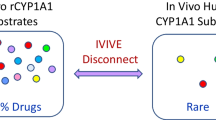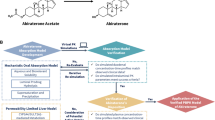Abstract
Objectives
This study aimed to characterize the effects of bovine serum albumin (BSA) on the kinetics of CYP2C8-catalyzed paclitaxel 6α-hydroxylation in vitro; determine whether the addition of BSA to incubations improves the prediction of paclitaxel hepatic clearance via this pathway in vivo; and assess interindividual variability in predicted clearance.
Methods
The kinetics of paclitaxel 6α-hydroxlation by human liver microsomes (HLM) and recombinant CYP2C8 were characterized in incubations performed with and without BSA (2% w/v) supplementation, and the in vitro kinetic data were extrapolated to provide estimates of in vivo clearances. The Simcyp population-based ADME simulator was used to determine interindividual variability in the predicted clearances.
Results
Supplementation of incubations of HLM with BSA resulted in a 3.6-fold increase in the microsomal intrinsic clearance for paclitaxel 6α-hydroxylation, due mainly to a reduction in Km (7.08 ± 2.50 to 2.26 ± 0.39 μM), while addition of BSA to incubations of recombinant CYP2C8 resulted in an approximate doubling of intrinsic clearance. Mean values of predicted in vivo hepatic clearance were in good agreement with clinical data when in vitro data obtained in the presence of BSA were used for IV-IVE. Simcyp predicted 20- to 30-fold interindividual variability in in vivo paclitaxel hepatic clearance via the 6α-hydroxylation pathway.
Conclusions
Human liver microsomal Km and intrinsic clearance values are over- and underpredicted, respectively, when incubations of the CYP2C8 substrate paclitaxel are performed without BSA supplementation. IV-IVE based on kinetic parameters generated in the presence of BSA improves the accuracy of predicted paclitaxel hepatic clearance.



Similar content being viewed by others
References
Houston JB (1994) Utility of in vitro drug metabolism data in predicting in vivo metabolic clearance. Biochem Pharmacol 47:1469–1479
Iwatsubo T, Hirota N, Ooie T, Suzuki H, Shimada N, Chiba K, Ishizaki T, Green CE, Tyson CA, Sugiyama Y (1997) Prediction of in vivo drug metabolism in the human liver from in vitro metabolism data. Pharmacol Ther 73:147–171
Miners JO, Mackenzie PI, Knights KM (2010) The prediction of drug-glucuronidation parameters in humans: UDP-glucuronosyltransferase enzyme-selective substrate and inhibitor probes for reaction phenotyping and in vitro-in vivo extrapolation of drug clearance and drug-drug interaction potential. Drug Metab Rev 42:189–201
Obach RS (1999) Prediction of human clearance of twenty-nine drugs from hepatic microsomal intrinsic clearance data: an examination of in vitro half-life approach and nonspecific binding to microsomes. Drug Metab Dispos 27:1350–1359
Proctor NJ, Tucker GT, Rostami-Hodjegan A (2004) Predicting drug clearance from recombinantly expressed CYPs: intersystem extrapolation factors. Xenobiotica 34:151–178
Riley RJ, McGinnity DF, Austin RP (2005) A unified model for predicting human hepatic, metabolic clearance from in vitro intrinsic clearance data in hepatocytes and microsomes. Drug Metab Dispos 33:1304–1311
Ito K, Houston JB (2005) Prediction of human drug clearance from in vitro and preclinical data using physiologically based and empirical approaches. Pharm Res 22:103–112
Miners JO, Knights KM, Houston JB, Mackenzie PI (2006) In vitro-in vivo correlation for drugs and other compounds eliminated by glucuronidation in humans: pitfalls and promises. Biochem Pharmacol 71:1531–1539
Rowland A, Elliot DJ, Knights KM, Mackenzie PI, Miners JO (2008) The "albumin effect" and in vitro-in vivo extrapolation: sequestration of long-chain unsaturated fatty acids enhances phenytoin hydroxylation by human liver microsomal and recombinant cytochrome P450 2C9. Drug Metab Dispos 36:870–877
Rowland A, Gaganis P, Elliot DJ, Mackenzie PI, Knights KM, Miners JO (2007) Binding of inhibitory fatty acids is responsible for the enhancement of UDP-glucuronosyltransferase 2B7 activity by albumin: implications for in vitro-in vivo extrapolation. J Pharmacol Exp Ther 321:137–147
Tsoutsikos P, Miners JO, Stapleton A, Thomas A, Sallustio BC, Knights KM (2004) Evidence that unsaturated fatty acids are potent inhibitors of renal UDP-glucuronosyltransferases (UGT): kinetic studies using human kidney cortical microsomes and recombinant UGT1A9 and UGT2B7. Biochem Pharmacol 67:191–199
Raungrut P, Uchaipichat V, Elliot DJ, Janchawee B, Somogyi AA, Miners JO (2010) In vitro-in vivo extrapolation predicts drug-drug interactions arising from inhibition of codeine glucuronidation by dextropropoxyphene, fluconazole, ketoconazole, and methadone in humans. J Pharmacol Exp Ther 334:609–618
Rowland A, Knights KM, Mackenzie PI, Miners JO (2008) The "albumin effect" and drug glucuronidation: bovine serum albumin and fatty acid-free human serum albumin enhance the glucuronidation of UDP-glucuronosyltransferase (UGT) 1A9 substrates but not UGT1A1 and UGT1A6 activities. Drug Metab Dispos 36:1056–1062
Tang C, Lin Y, Rodrigues AD, Lin JH (2002) Effect of albumin on phenytoin and tolbutamide metabolism in human liver microsomes: an impact more than protein binding. Drug Metab Dispos 30:648–654
Kilford PJ, Stringer R, Sohal B, Houston JB, Galetin A (2009) Prediction of drug clearance by glucuronidation from in vitro data: use of combined cytochrome P450 and UDP-glucuronosyltransferase cofactors in alamethicin-activated human liver microsomes. Drug Metab Dispos 37:82–89
Uchaipichat V, Winner LK, Mackenzie PI, Elliot DJ, Williams JA, Miners JO (2006) Quantitative prediction of in vivo inhibitory interactions involving glucuronidated drugs from in vitro data: the effect of fluconazole on zidovudine glucuronidation. Br J Clin Pharmacol 61:427–439
Matsumoto S, Ding LR, Ishii M, Fischer NE, Inaba T (2002) The interaction of human and bovine serum proteins with CYP3A in human liver microsomes: inhibition of testosterone 6beta-hydroxylation by albumin, alpha-globulins, alpha(1)-acid glycoprotein and gamma-globulins. Toxicol Lett 136:33–41
Xu BQ, Ishii M, Ding LR, Fischer NE, Inaba T (2003) Interaction of serum proteins with CYP isoforms in human liver microsomes: inhibitory effects of human and bovine albumin, alpha-globulins, alpha-1-acid glycoproteins and gamma-globulins on CYP2C19 and CYP2D6. Life Sci 72:1953–1962
Rowland A, Elliot DJ, Williams JA, Mackenzie PI, Dickinson RG, Miners JO (2006) In vitro characterization of lamotrigine N2-glucuronidation and the lamotrigine-valproic acid interaction. Drug Metab Dispos 34:1055–1062
Rifkind AB, Lee C, Chang TK, Waxman DJ (1995) Arachidonic acid metabolism by human cytochrome P450s 2 C8, 2 C9, 2E1, and 1A2: regioselective oxygenation and evidence for a role for CYP2C enzymes in arachidonic acid epoxygenation in human liver microsomes. Arch Biochem Biophys 320:380–389
Ferguson SS, Black K, Jackson JP (2008) The CYP2C subfamily. In: Ioannides C (ed) Cytochrome P450: role in the metabolism and toxicity of drugs and other xenobiotics. The Royal Society of Chemistry, Cambridge, p 206
Kerdpin O, Elliot DJ, Boye SL, Birkett DJ, Yoovathaworn K, Miners JO (2004) Differential contribution of active site residues in substrate recognition sites 1 and 5 to cytochrome P450 2 C8 substrate selectivity and regioselectivity. Biochemistry 43:7834–7842
Cresteil T, Monsarrat B, Alvinerie P, Treluyer JM, Vieira I, Wright M (1994) Taxol metabolism by human liver microsomes: identification of cytochrome P450 isozymes involved in its biotransformation. Cancer Res 54:386–392
Polasek TM, Elliot DJ, Lewis BC, Miners JO (2004) Mechanism-based inactivation of human cytochrome P4502C8 by drugs in vitro. J Pharmacol Exp Ther 311:996–1007
Yamazaki H, Shimada T (1999) Effects of arachidonic acid, prostaglandins, retinol, retinoic acid and cholecalciferol on xenobiotic oxidations catalysed by human cytochrome P450 enzymes. Xenobiotica 29:231–241
Sonnichsen DS, Relling MV (1994) Clinical pharmacokinetics of paclitaxel. Clin Pharmacokinet 27:256–269
Tassaneeyakul W, Birkett DJ, McManus ME, Tassaneeyakul W, Veronese ME, Andersson T, Tukey RH, Miners JO (1994) Caffeine metabolism by human hepatic cytochromes P450: contributions of 1A2, 2E1 and 3A isoforms. Biochem Pharmacol 47:1767–1776
Boye SL, Kerdpin O, Elliot DJ, Miners JO, Kelly L, McKinnon RA, Bhasker CR, Yoovathaworn K, Birkett DJ (2004) Optimizing bacterial expression of catalytically active human cytochromes P450: comparison of CYP2C8 and CYP2C9. Xenobiotica 34:49–60
McLure JA, Miners JO, Birkett DJ (2000) Nonspecific binding of drugs to human liver microsomes. Br J Clin Pharmacol 49:453–461
Rowland-Yeo K, Rostami-Hodjegan A, Tucker GT (2004) Abundance of cytochromes P450 in human liver: a meta-analysis. Br J Clin Pharmacol 57:687–688
Walle T, Walle UK, Kumar GN, Bhalla KN (1995) Taxol metabolism and disposition in cancer patients. Drug Metab Dispos 23:506–512
van Tellingen O, Huizing MT, Panday VR, Schellens JH, Nooijen WJ, Beijnen JH (1999) Cremophor EL causes (pseudo-) non-linear pharmacokinetics of paclitaxel in patients. Br J Cancer 81:330–335
Sparreboom A, van Zuylen L, Brouwer E, Loos WJ, de Bruijn P, Gelderblom H, Pillay M, Nooter K, Stoter G, Verweij J (1999) Cremophor EL-mediated alteration of paclitaxel distribution in human blood: clinical pharmacokinetic implications. Cancer Res 59:1454–1457
Hakooz N, Ito K, Rawden H, Gill H, Lemmers L, Boobis AR, Edwards RJ, Carlile DJ, Lake BJ, Houston JB (2006) Determination of a human hepatic scaling factor for predicting in vivo drug clearance. Pharmacol Res 23:533–539
Polasek TM, Polak S, Doogue MP, Rostami-Hodjegan A, Miners JO (2009) Assessment of inter-individual variability in predicted phenytoin clearance. Eur J Clin Pharmacol 65:1203–1210
Rostami-Hodjegan A, Tucker GT (2007) Simulation and prediction of in vivo drug metabolism in human populations from in vitro data. Nat Rev Drug Discov 6:140–14837
Schoch GA, Yano JK, Wester MR, Griffin KJ, Stout CD, Johnson EF (2004) Structure of human microsomal cytochrome P450 2 C8. Evidence for a peripheral fatty acid binding site. J Biol Chem 279:9497–9503
Kumar GN, Walle UK, Walle T (1994) Cytochrome P450 3A-mediated human liver microsomal taxol 6 alpha-hydroxylation. J Pharmacol Exp Ther 268:1160–1165
Ong CE, Coulter S, Birkett DJ, Bhasker CR, Miners JO (2000) The xenobiotic inhibitor profile of cytochrome P4502C8. Br J Clin Pharmacol 50:573–580
Vaclavikova R, Horsky S, Simek P, Gut I (2003) Paclitaxel metabolism in rat and human liver microsomes is inhibited by phenolic antioxidants. Naunyn Schmiedebergs Arch Pharmacol 368:200–209
Ludden LK, Ludden TM, Collins JM, Pentikis HS, Strong JM (1997) Effect of albumin on the estimation, in vitro, of phenytoin Vmax and Km values: implications for clinical correlation. J Pharmacol Exp Ther 282:391–396
Henningsson A, Marsh S, Loos WJ, Karlsson MO, Garsa A, Mross K, Mielke S, Vigano L, Locatelli A, Verweij J, Sparreboom A, McLeod HL (2005) Association of CYP2C8, CYP3A4, CYP3A5, and ABCB1 polymorphisms with the pharmacokinetics of paclitaxel. Clin Cancer Res 11:8097–8104
Marsh S, Somlo G, Li X, Frankel P, King CR, Shannon WD, McLeod HL, Synold TW (2007) Pharmacogenetic analysis of paclitaxel transport and metabolism genes in breast cancer. Pharmacogenomics J 7:362–365
Bergmann TK, Brasch-Andersen C, Green H, Mirza M, Pedersen RS, Nielsen F, Skougaard K, Wihl J, Keldsen N, Damkier P, Friberg LE, Peterson C, Vach W, Karlsson MO, Brosen K (2010) Impact of CYP2C8*3 on paclitaxel clearance: a population pharmacokinetic and pharmacogenomic study in 93 patients with ovarian cancer. Pharmacogenomics J. doi:10.1038/tpj.2010.19
Green H, Soderkvist P, Rosenberg P, Mirghani RA, Rymark P, Lundqvist EA, Peterson C (2009) Pharmacogenetic studies of paclitaxel in the treatment of ovarian cancer. Basic Clin Pharmacol Toxicol 104:130–137
Jamei M, Marciniak S, Feng K, Barnett A, Tucker G, Rostami-Hodjegan A (2009) The Simcyp population-based ADME simulator. Expert Opin Drug Metab Toxicol 5:211–223
Howgate EM, Rowland Yeo K, Proctor NJ, Tucker GT, Rostami-Hodjegan A (2006) Prediction of in vivo drug clearance from in vitro data I: impact of inter-individual variability. Xenobiotica 36:473–497
Acknowledgments
This study was supported by grants from the National Health and Medical Research Council of Australia, the Thailand Research Fund, and the Faculty of Medicine, Khon Kaen University, Thailand. Financial support from the Thailand Research Fund through the Royal Golden Ph.D. Program (PHD/0167/2548) to Nitsupa Wattanachai and Wichittra Tassaneeyakul is acknowledged. Assistance from David J. Elliot in establishing the paclitaxel 6α-hydroxylation assay and performing the binding experiments is gratefully acknowledged.
Conflict of interest
The authors declare that they have no conflicts of interest.
Author information
Authors and Affiliations
Corresponding author
Rights and permissions
About this article
Cite this article
Wattanachai, N., Polasek, T.M., Heath, T.M. et al. In vitro–in vivo extrapolation of CYP2C8-catalyzed paclitaxel 6α-hydroxylation: effects of albumin on in vitro kinetic parameters and assessment of interindividual variability in predicted clearance. Eur J Clin Pharmacol 67, 815–824 (2011). https://doi.org/10.1007/s00228-011-1001-z
Received:
Accepted:
Published:
Issue Date:
DOI: https://doi.org/10.1007/s00228-011-1001-z




